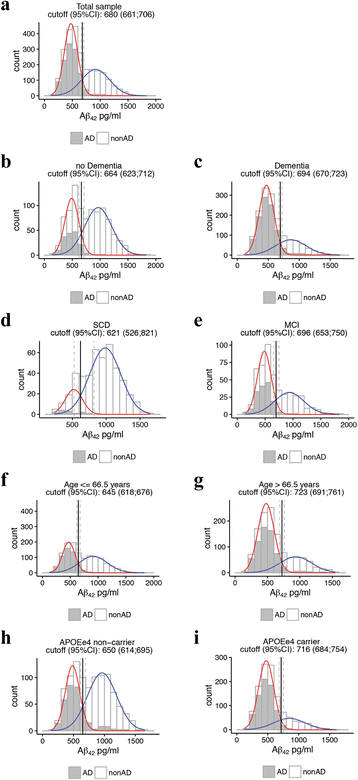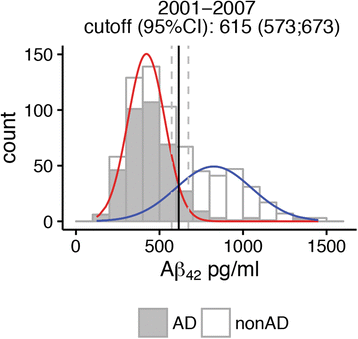Unbiased estimates of cerebrospinal fluid β-amyloid 1-42 cutoffs in a large memory clinic population
- PMID: 28193256
- PMCID: PMC5307885
- DOI: 10.1186/s13195-016-0233-7
Unbiased estimates of cerebrospinal fluid β-amyloid 1-42 cutoffs in a large memory clinic population
Abstract
Background: We sought to define a cutoff for β-amyloid 1-42 in cerebrospinal fluid (CSF), a key marker for Alzheimer's disease (AD), with data-driven Gaussian mixture modeling in a memory clinic population.
Methods: We performed a combined cross-sectional and prospective cohort study. We selected 2462 subjects with subjective cognitive decline, mild cognitive impairment, AD-type dementia, and dementia other than AD from the Amsterdam Dementia Cohort. We defined CSF β-amyloid 1-42 cutoffs by data-driven Gaussian mixture modeling in the total population and in subgroups based on clinical diagnosis, age, and apolipoprotein E (APOE) genotype. We investigated whether abnormal β-amyloid 1-42 as defined by the data-driven cutoff could better predict progression to AD-type dementia than abnormal β-amyloid 1-42 defined by a clinical diagnosis-based cutoff using Cox proportional hazards regression.
Results: In the total group of patients, we found a cutoff for abnormal CSF β-amyloid 1-42 of 680 pg/ml (95% CI 660-705 pg/ml). Similar cutoffs were found within diagnostic and APOE genotype subgroups. The cutoff was higher in elderly subjects than in younger subjects. The data-driven cutoff was higher than our clinical diagnosis-based cutoff and had a better predictive accuracy for progression to AD-type dementia in nondemented subjects (HR 7.6 versus 5.2, p < 0.01).
Conclusions: Mixture modeling is a robust method to determine cutoffs for CSF β-amyloid 1-42. It might better capture biological changes that are related to AD than cutoffs based on clinical diagnosis.
Keywords: Alzheimer’s disease; Cerebrospinal fluid; Diagnosis; MCI.
Figures


References
-
- Sperling RA, Aisen PS, Beckett LA, Bennett DA, Craft S, Fagan AM, et al. Toward defining the preclinical stages of Alzheimer’s disease: recommendations from the National Institute on Aging-Alzheimer’s Association workgroups on diagnostic guidelines for Alzheimer’s disease. Alzheimers Dement. 2011;7(3):280–92. doi: 10.1016/j.jalz.2011.03.003. - DOI - PMC - PubMed
-
- Albert MS, DeKosky ST, Dickson D, Dubois B, Feldman HH, Fox NC, et al. The diagnosis of mild cognitive impairment due to Alzheimer’s disease: recommendations from the National Institute on Aging-Alzheimer’s Association workgroups on diagnostic guidelines for Alzheimer’s disease. Alzheimers Dement. 2011;7(3):270–9. doi: 10.1016/j.jalz.2011.03.008. - DOI - PMC - PubMed
-
- McKhann GM, Knopman DS, Chertkow H, Hyman BT, Jack CR, Jr, Kawas CH, et al. The diagnosis of dementia due to Alzheimer’s disease: recommendations from the National Institute on Aging-Alzheimer’s Association workgroups on diagnostic guidelines for Alzheimer’s disease. Alzheimers Dement. 2011;7(3):263–9. doi: 10.1016/j.jalz.2011.03.005. - DOI - PMC - PubMed
MeSH terms
Substances
LinkOut - more resources
Full Text Sources
Other Literature Sources
Medical
Miscellaneous

